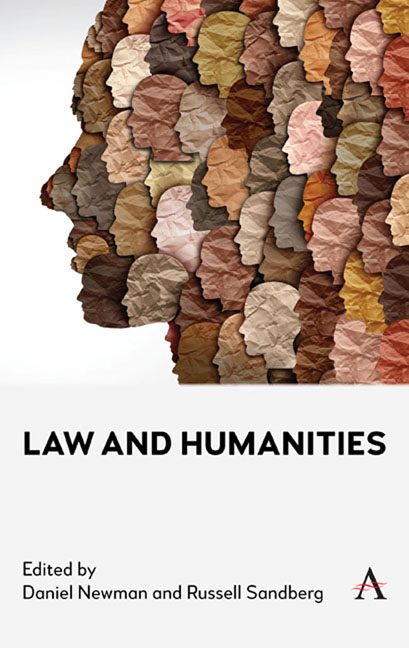Book contents
- Frontmatter
- Contents
- Preface
- List of Contributors
- Chapter One Introducing Law and Humanities
- Chapter Two Law and Archaeology
- Chapter Three Law and Comics/Graphic Justice
- Chapter Four Law and Film
- Chapter Five Law and Geography
- Chapter Six Law and History
- Chapter Seven Law and Literature
- Chapter Eight Law and Philosophy
- Chapter Nine Law and Popular Music
- Chapter Ten Law and Religion
- Chapter Eleven Law and Television
- Chapter Twelve Law and Theatre
- Chapter Thirteen Law and Theology
- Chapter Fourteen Law and Video Games
- Chapter Fifteen Conclusion: Subverting the Law and Humanities Canon
- Index
Chapter Two - Law and Archaeology
Published online by Cambridge University Press: 27 March 2024
- Frontmatter
- Contents
- Preface
- List of Contributors
- Chapter One Introducing Law and Humanities
- Chapter Two Law and Archaeology
- Chapter Three Law and Comics/Graphic Justice
- Chapter Four Law and Film
- Chapter Five Law and Geography
- Chapter Six Law and History
- Chapter Seven Law and Literature
- Chapter Eight Law and Philosophy
- Chapter Nine Law and Popular Music
- Chapter Ten Law and Religion
- Chapter Eleven Law and Television
- Chapter Twelve Law and Theatre
- Chapter Thirteen Law and Theology
- Chapter Fourteen Law and Video Games
- Chapter Fifteen Conclusion: Subverting the Law and Humanities Canon
- Index
Summary
Introduction: Legal Archaeology – Methodology or Metaphor?
This chapter explores the intersection of the disciplines of law and archaeology, through the lens of the methodology of legal archaeology. Law and archaeology both involve physical and intellectual activity, and connections between law and archaeology can arise in different ways. Archaeologists need to follow law and regulations for managing archaeological sites, including how they carry out excavations and in relation to what they find. For example, there are laws which regulate the finding of artefacts classed as treasure, certain historical sites are protected by the law and a licence is needed for the excavation of human remains. Materials or objects excavated during an archaeological dig might give insights about the law at a particular time or tell us something about historical relationships between people and the law. Much like other ‘law and’ movements, there are different ways in which we could depict the various interactions between law and archaeology. We might examine ‘law as archaeology’, whereby law is analysed using what would usually be an archaeological approach, or ‘archaeology as law’, where archaeological research is conducted according to approaches that are more familiar to law researchers. We can also consider ‘law of archaeology’, exploring how archaeology is subject to legal regulation, or ‘law in archaeology’, investigating what an archaeological finding can tell us about law, or perhaps ‘archaeology of law’, which could involve analysis of law inspired by archaeological techniques.
This chapter is not concerned with all the possible ways in which the disciplines of law and archaeology interact but is primarily focused on exploring the methodology of legal archaeology, to consider whether we can learn more about its scope by looking to the discipline of archaeology itself, rather than simply using archaeology-related terminology as a metaphor. Thus, the aim of this chapter is to outline the current understandings of legal archaeology alongside an examination of aspects of what archaeologists do, in order to highlight the extent to which the discipline of archaeology has synergies with legal archaeology. The purpose of this analysis is to enable us to consider the use of the archaeology language within this approach and help us to realise legal archaeology as an established and recognisable socio-legal methodology, rather than simply as a metaphor or as something that is absorbed into the canon of legal history.
- Type
- Chapter
- Information
- Law and Humanities , pp. 21 - 36Publisher: Anthem PressPrint publication year: 2024

